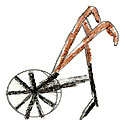Breaking Ground
Now that the time has come to begin your garden project, there are several things to consider. The first is your site.
Where Will Your Garden Go?
This question is very important, as it can determine the success or failure of your garden. Many teachers want to have their gardens right outside their classrooms for the convenience and the possibility for keeping an eye on the garden.
But sometimes this may not be the ideal site. When locating the ideal site for your garden, you will need to consider soil, sun, a water source, water drainage, existing vegetation, accessibility, and student traffic.
- Soil: Soil is one the most important elements in considering a garden site. Soil testing is important for determining the soil type and what, if any, amendments are needed. Soil testing is a project that your students may wish to consider, and you may have your local county extension service assist. Well-drained soil is also a must for any successful garden.
- Sun: Adequate sunlight is essential for any garden. Six hours of direct sunlight is required for most garden plants, including vegetables and flowers. There are a wide variety of plants that will tolerate shady conditions if there is little sunlight on your campus.
- Water Source: You or your students will need to water the garden almost every day. It is important that you have a water source readily accessible to the garden. Automatic irrigation systems can also be used.
- Water Drainage: Watch prospective sites after a rain to determine the extent of water drainage and runoff. Standing water can cause your garden many problems, such as root rot, which will kill your plants. A high level of water drainage can also be detrimental as it can wash away seeds, young plants, and soil amendments. Standing water and high runoff are both problems that can be fixed, but you will need to know they exist before starting your garden.
- Existing Vegetation: Are there plants around your site that you wish to keep for your garden or are there ones that will require removal?
- Accessibility: Consider how accessible your site is to you, your students, and other participants. Also consider the accessibility for garden maintenance or perhaps wildlife that may be attracted to your garden. An unfortunate factor that should be considered is the accessibility of your garden to vandals. Is the site a safe place for your students? Will a building be required to lock up valuable tools and supplies?
- Student Traffic: Is the site you are considering in an area of high student traffic and if so, how will this affect your garden and garden activities?
Garden Design, Layout & Plant Selection
The type of garden you decide to plant will determine your garden design, layout, and plant selection.
- Design & Layout: Is your garden to be a vegetable, flower, butterfly, or a combination garden? Will you need paths, individual plots, raised beds, and/or borders? How many plants will you have? How much space will you need? Is there room for expansion? Are you going to include an irrigation system? Allowing your students to design the garden can become a fun activity for you and students. Figuring out the design and layout will also be a lot easier if you have established your goals and objectives for the garden. There are numerous books and resources available to assist with garden design and layout.
- Plant Selection: Your plant selection will depend on the type of garden you intend to create. The possibilities are endless when deciding on plants, but you will need to make sure the plants you want will grow in your area. Your local nursery or county extension office will be able to help you determine which plants grow best. In addition to plants, you may want to consider sowing seeds. Seeds are relatively cheap and some seed companies may donate or discount them for your project. Seeds also offer great science lessons and indoor projects.

